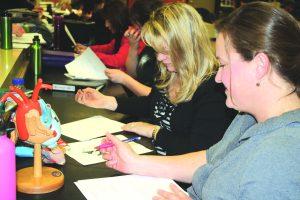Kirsteen Wolf
The Broadside
The setting in the new science building will be a leap forward from current conditions. However some science faculty feel

there will be a gap between the level of education intended and the level that can actually be delivered unless additional qualified science instructors are hired at Central Oregon Community College.
Science courses had 1782 occupied seats during winter term 2012. Faculty cite needs for instructors in chemistry, anatomy and physiology, physics and engineering.
“We’ll still have a staffing issue in the new building,” said Bruce Emerson, professor in the physics and engineering department.
There are plans to hire two new tenure-track faculty in biology and chemistry who will begin this fall when the new science building will open.
“We are also hiring a new lab tech as well as a shared position, with Testing and Tutoring, that will be a lab tech supervisor and science tutor,” said Michael Holtzclaw, instructional dean for COCC.
Some faculty wonder about the ability to keep up with class sizes and demand while still delivering quality instruction. For instance, holding lab sizes to a maximum of 27 is crucial for quality control in order to “teach the way students need to be taught and want to be taught,” according to Christine Ott-Hopkins, biology professor.
Emerson recognizes the improvement in facilities when the department moves to the 45,000 square foot building. But he does not equate it with a better experience for students without more faculty to fill in the gaps in the departments.
“The building is a front end investment,” Emerson said. “Then it’s all about the people you put in it.”
Holtzclaw sees the new facility as a step in the right direction in meeting the demand for science classes.
“We have had a tremendous number of students in the past who couldn’t get into some of the key science courses and we have been unable to serve them due to the lack of labs,” he said. “The new building, combined with a planned expansion of science labs in Redmond, should help alleviate some of the roadblocks.”
Innovative education
While Both Emerson and Julie Hood Gonsalves, science and Allied Health professor and chair of Allied Health, think the new building’s facilities meet current best practices for teaching, they don’t go above and beyond.
“I think it meets best practices,” Hood Gonsalves said. “We should be evolving away from “seat time” and into measuring competence of outcomes.”
One of the new labs in the science building moves toward the less “seat time” model. It’s a large lab that combines open, group learning that emphasizes experiential participation and collaboration. Students and faculty from all disciplines can use the facility. It can also function as a classroom.
Staff refer to it as the “Fred” lab. The name is unofficial but is widely used. It originated at a design meeting when someone said that the lab needed a distinctive name.
“So one of the architects piped up ‘Let’s call it Fred,’” said Hood Gonsalves. “It stuck.”
The idea for the lab came about when faculty were asking for an “open lab” said Hood Gonsalves, where the equipment is set up for a couple of days and students from different classes could take the time they needed to learn instead of being limited by their class lab times.
To go beyond current best practice in science teaching, Emerson thinks that every lab should be set up like the “Fred” lab so an “integrated, experiential learning environment” happens all over the building. While certain students and instructors may prefer a different method of teaching and learning, Hood Gonsalves feels that the nature of the “Fred” lab could be the open door to “helping students learn about what they need to succeed and be competent, rather than simply putting time into a class.”
The new building
The new home of the science department will be a welcome change for many.
“It will be so nice to be in a building that’s fresh with a new design and new facilities,” said Ott-Hopkins.
There will be work spaces for students throughout the building with white boards and tables and even wax crayons for problem solving on the building’s many windows.
For Holtzclaw, the increased lab space is the most exciting part of the new science building.
“There was a conscious effort to focus on increasing lab capacity to address needs now and into the near future,” he said. “With this expansion we will be able satisfy the science demands for some time, providing we have enough staffing.”
(Contact: [email protected])







